Persistent Identifiers (PIDs) are part of the open research infrastructure that helps to make research and scholarly resources more FAIR (Findable, Accessible, Interoperable and Reusable).
According to the US Department of Energy’s Office of Science and Technical Information, “A PID is a digital identifier that is globally unique, persistent, machine resolvable, has an associated metadata schema, identifies an entity and is frequently used to disambiguate between entities” (PIDs@OSTI.gov).
The three most widely used open PIDs are ORCID, DOIs, and ROR.
- ORCID (Open Researcher & Contributor Identifier) iD — identifies individuals and distinguishes individuals from each other. A researchers’ ORCID iD can contain metadata about themselves, such as their institutional affiliations and research activities (similar to information that would be found on a CV or resume).
- DOI (Digital Object Identifier) — provided by DataCite and Crossref, used to identify objects/things, such as publications, research data, data management plans, grants (Crossref Grant DOIs) and much more.
- ROR (Research Organization Registry) ID — used to identify research organizations such as universities, funders, companies, laboratories and research institutes.
How do PIDs work together?
PIDs allow us to connect people, organizations and things together in a machine-actionable way so that these entities and the connections between them can be found, identified, referenced and credited accurately. This can help with future research as well as assessing the reach, return on investment and impact of activities in the research landscape. Each PID requires metadata, or information about the person, thing or organization that the identifier is identifying, and different PIDs can be included in the metadata of other PIDs:
- ORCID iDs can be included in DOI metadata to identify the people involved in the existence of the object that the DOI is identifying.
- DOIs can be included in an ORCID record to identify the works that a person has produced, or the funding that a person has received.
- ROR IDs can be included in ORCID records to identify the organizations that an individual is affiliated with.
- ROR IDs can be included in DOI metadata to identify the organizations that are involved in the existence of the object that the DOI is identifying.
For example: A work entry in an individual’s ORCID record (https://orcid.org/0000-0002-1196-6279) includes the DOI (https://doi.org/10.17605) assigned to the work:

An employment entry in an individual’s ORCID record (https://orcid.org/0000-0002-1196-6279) includes the ROR ID (https://ror.org/0293rh119) of the employer organization:
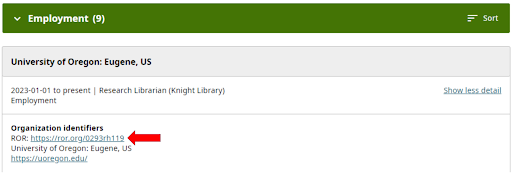
A funding entry in an individual’s ORCID record (https://orcid.org/0000-0002-7798-8024) includes the Grant DOI (https://doi.org/10.58275/AHA.23AIREA1051613.pc.gr.167525) of the funding award:

The DOI metadata and landing page for a work (https://doi.org/10.7554/eLife.88088) includes a Grant DOI (https://doi.org/10.58275/aha.23post1011626.pc.gr.161347) to indicate a source of funding for the work:
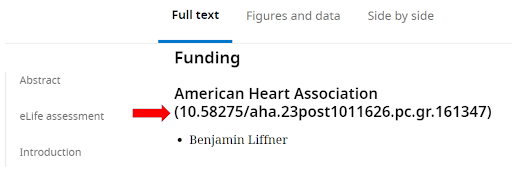
The DOI metadata and landing page for a work (https://doi.org/10.7554/eLife.88088) includes the ORCID iD of the work’s creator (https://orcid.org/0000-0002-1573-6139):
The DOI metadata for a work (https://doi.org/10.7554/eLife.88088.3) includes the DOIs of items that are related to the work (https://doi.org/10.1128/mBio.00130-18, https://doi.org/10.1083/jcb.35.1.103, https://doi.org/10.1016/0014-4894(71)90094-4, https://doi.org/10.1016/B978-0-12-394309-5.00001-8):
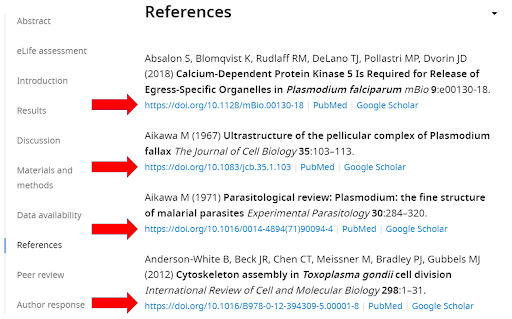
The DOI metadata for a work (https://doi.org/10.48609/rmkv-5710) includes the ROR ID of the author’s home institution/employer (https://ror.org/047426m28):
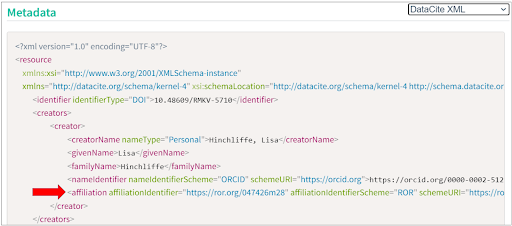
A Grant DOI (https://doi.org/10.58275/AHA.23POST1011626.pc.gr.161347) includes the ORCID iD of the grant’s principal investigator (https://orcid.org/0000-0002-1573-6139):
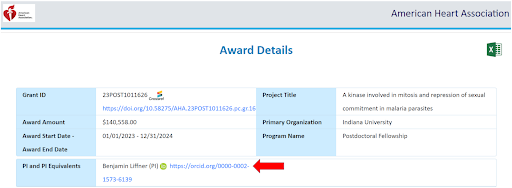
A Grant DOI (https://doi.org/10.54514/f7n3d) includes the ROR ID of the investigator’s home institution/employer (https://ror.org/05gxnyn08):
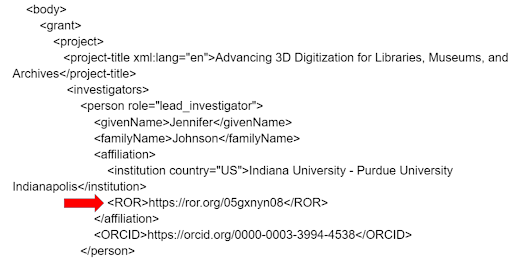
How to enable and/or find PID connections?
To connect PIDs together, different stakeholders must be involved to ensure that relevant PIDs are included in the metadata of other PIDs. For example, publishers and repositories must make sure that relevant ORCID iDs, ROR IDs and related resource DOIs are included in the metadata of the DOIs that they assign to publications, datasets and other research outputs. Similarly, funders must make sure that relevant ORCID iDs, ROR IDs and DOIs are included in the metadata of the Grant DOIs that they assign to grants. Organizations writing data to ORCID records must ensure that relevant DOIs and ROR IDs are included in the metadata that gets pushed to ORCID. Researchers can also do their part by making sure relevant DOIs are included in their ORCID records. All of these stakeholder groups rely on tools and platforms to integrate PID functionalities where possible to support the creation and connection of PIDs.
The metadata connections that are created by using multiple PIDs together can be leveraged to:
- Identify the people associated with a particular institution, work, grant, or other activity
- Identify the works associated with a particular person, organization, funding, or other entity
- Identify the organizations associated with a particular person, work, or other activity or initiative
Some tools and services are available to assist in creating or exposing these connections, such as:
- ORCID US Community Data Visualization Resources — an openly available R script and Tableau Public dashboard can be used to find and visualize all of the publication collaborations of researchers at a home institution, based on the presence of Crossref DOIs in researchers’ ORCID records, and ORCID iDs in Crossref DOI metadata.
- Crossref ORCID Search & Link Wizard — individual researchers can connect their ORCID iD with the “Crossref Metadata Search” Search & Link wizard within ORCID to claim past works that have a Crossref DOI to their ORCID record. To have current and future works automatically added to ORCID, researchers should provide their ORCID iD to publishers, and authorize permission for Crossref to add works to their ORCID record when they receive a notification from Crossref in their ORCID inbox.
- DataCite ORCID Search & Link Wizard — individual researchers can connect their ORCID iD with the “DataCite” Search & Link wizard within ORCID so that future works that have a DataCite DOI, with the researcher’s ORCID iD in the DOI metadata, will be automatically pushed to their ORCID record.
- DataCite Commons — researchers can link past works that have a DataCite DOI to their ORCID record through DataCite Commons, and anyone can use DataCite Commons to explore connections between works, people, organizations and repositories, based on connected PID metadata.
- REST APIs (application programming interfaces) — ROR, ORCID, DataCite, and Crossref all have APIs that can be used to query their metadata to find connections or add other related PIDs to their metadata. Several software systems have various PID APIs already integrated; for a list of ORCID-integrated systems specifically, see the ORCID US Community list of common systems. The ORCID Affiliation Manager is also available for organizations that are members of the ORCID US Community.
How are PIDs used in the Research Lifecycle?
PIDs can be helpful at all stages of the research process, for example:
When a researcher applies for and receives funding to do research:
- The funding organization can request researchers to use their ORCID iD and share data from their ORCID record to identify themselves. This saves time when disclosing information in grant applications.
- The funding organization can use grants management systems that are ROR-enabled to make sure researchers' home organizations are correctly and consistently identified when grant information is shared with other systems.
- The funding organization can assign a Grant DOI to the grant award, and use it as a tool to track outputs associated with the grant.
- The funding organization can add funding information, including the Grant DOI, to the researcher’s ORCID record to confirm that the researcher received funding from the organization.
When a researcher conducts their research:
- The researcher can find related research using the DOIs assigned to those materials, listed in the references of other research publications.
- If the researcher is using special equipment, facilities or other resources, the organization providing access to those resources can collect the researcher’s ORCID iD and add research resource usage information to the researcher’s ORCID record. This tracks who is using their resources and for what research those resources are being used.
When a researcher writes an article or compiles their research findings for sharing:
- The researcher can accurately identify/cite their sources using the DOIs assigned to those sources.
- The researcher can accurately identify contributors involved in the research by including each person’s ORCID iD.
When a researcher submits their article for publication:
- The publisher can assign a DOI to the publication, so that it can be accurately found and cited in future works.
- The publisher can ask for the researcher’s ORCID iD, to be included in the publication DOI metadata.
- The publisher can use ROR IDs to standardize researcher affiliations in manuscript submission systems and in DOI metadata.
- The researcher can have their publication information automatically added to their ORCID record by either the publisher or the DOI registration agency (Crossref or DataCite).
When a researcher/contributor conducts peer review, the publisher can ask for peer reviewers’ ORCID iDs, and add peer review activity to the reviewers’ ORCID records.
When a researcher reports their activities back to their funder and/or home institution/employer, rather than having to manually type and fill out reporting forms repeatedly, the organization can allow the researcher to use their ORCID iD and ORCID record to send information about their activities to the funder or employer.
Other Examples or Questions
Do you have other examples or questions about where and how PIDs can work together in the research ecosystem? Please contact orcidus@lyrasis.org.
Many thanks to the following people for reviewing this post:
- Brian Minihan, Engagement Lead at ORCID
- Kelly Stathis, Technical Community Manager at DataCite
- Xiaoli Chen, FAIR Workflow Project Lead at DataCite
- Amanda French, Technical Community Manager for ROR (at Crossref)
- Kaela Ramhit, ORCID US Community Program Assistant at Lyrasis
